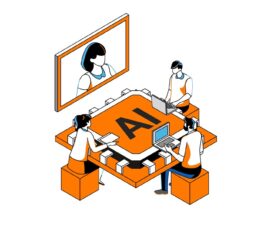- A team at Orange Innovation China has developed a tool capable of measuring the greenhouse gas emissions of different artificial intelligence models based on their use.
- The tool provides tips on how to optimize to help reduce this carbon footprint. In the future, it will be able to help eco-design AI models.
At Orange Open Tech Days 2023, a team of researchers from Orange Innovation China will live-demo a tool designed to measure the carbon footprint of AI and suggest optimizations. Climate change makes tools like this essential for anticipating the impact that future technologies will have on the environment. “AI can help reduce humanity’s carbon footprint. Its contribution to the ecological transition is estimated at a 5–10% reduction in greenhouse gas (GHG) emissions by 2030,” says Lan Wang from Beijing-based Orange Innovation China. “But we cannot ignore the GHG emissions generated by AI itself. It can be a very energy-intensive technology, especially when it comes to tools like ChatGPT.” A single ’s machine learning consumes 56 times as much energy as the average American citizen per year.
AI can help reduce humanity’s carbon footprint. But we cannot ignore the greenhouse gas emissions generated by AI itself.
Fit-for-Purpose AI
The tool born of the AI & carbon footprint – Measure & optimize a system project is based on four pillars. “Firstly, we wanted to interrogate AI use,” explains Lan Wang. “If I can get somewhere by bike, why should I go by car? The exact same reasoning holds for AI.” Energy optimization is the next pillar, in particular by assessing the environmental impact of the cloud servers of a given AI tool based on their location. The tool thus takes into account environmental legislation, the various energy mixes (in particular the renewable energy component) and even the carbon intensity of each country. “Limiting the scale of machine learning by offering tailored AI models is our third pillar,” says Wang. “In some cases, increasing the number of complete learning cycles (epochs) does not necessarily lead to better results, because performance tends toward a limit with further progress becoming negligible but energy consumption remaining high.” The last pillar is making AI algorithms themselves more sustainable by measuring their carbon footprint and optimizing models.
Lower Carbon Footprints
The tool designed by Orange Innovation China researchers collects real-time to measure the carbon footprint of an AI program. It provides statistical comparisons, such as the number of trees that would be needed to absorb the carbon emitted as a result of using the AI. “The tool then offers various solutions for optimizing the models, such as reducing the number of operations or reducing the logical layers of the model,” says Lan Wang. “Through knowledge distillation, a powerful AI model can train smaller AI ‘ .’ It is thus possible to considerably reduce the computing power needed and, therefore, the corresponding energy consumption, in exchange for a less than 10% reduction in the performance of the student models.” During its research, the laboratory found it could reduce energy consumption by up to 70% during the training phase and 60% during the phase. “Making AI fit for purpose is very positive both environmentally and economically.”
Significant Potential
The demo at Orange Open Tech Days will involve two AI models trained to track multiple objects (in this case for a soccer match). The first model is the original, before optimization. The second is the student model which, after optimization via the tool, requires less computing power. Visitors will be able to compare their results directly on screen. “Our tool has the advantage of being easy to install, easy to use, and compatible with most existing IT hardware due to its interoperability,” Wang goes on to explain. The tool is intended for everyone who uses AI, server and cloud providers, researchers, and so on. In the future, it is to be integrated directly into AI eco-design. However, there is still a long way to go before the final version. “Although our tool is already operational, we are still in the research phase. It works, but it has not yet reached its full potential — far from it,” concludes Lan Wang. Following on from GHG emissions, the tool is already being adapted to measure the impact of AI on water consumption.











